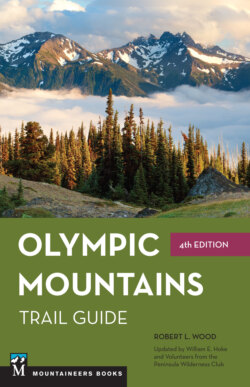Читать книгу Olympic Mountains Trail Guide - Robert Wood - Страница 17
На сайте Литреса книга снята с продажи.
THE RAIN FOREST
ОглавлениеOne of the few temperate-zone rain forests in the world, the Olympic rain forest (actually comprised of four separate rain forests) is confined to the windward slopes of the Olympic Mountains between sea level and approximately 2000 feet elevation. Rainfall exceeds 12 feet a year, occurring mostly during the winter months. Because this forest is located on the windward side of the mountains, where it is exposed to rain and fog and protected from cold east winds, the luxuriance of vegetation is comparable to that of equatorial rain forests.
The rain forest is a complex community of plants and animals that are interdependent—living and dying together, competing and cooperating with one another. Elk browse in the mingled sunlight and shadow, squirrels and chipmunks scurry over the forest floor, and salmon leap the cascades in the creeks and rivers. Standing over all are the big trees. The most common ones are Douglas-fir, western hemlock, western red cedar, and Sitka spruce. They overshadow the bigleaf maples and black cottonwoods, and the still lower understory of red alder, vine maple, devil’s club, and low-growing shrubs. Occasionally, rain-forest conditions extend to higher altitudes, into the zone of silver fir, yew, and grand fir.
The strange appearance of the rain forest is due to thick growths of mosses, liverworts, ferns, and lichens. The mosses that live upon the ground are sustained by nutrients obtained from the soil; those that cling to the trees are dependent upon nourishment transported by the wind. Selaginella, the most common growth, is not a true moss but a club moss, with sprigs that resemble reindeer antlers. This plant festoons almost every branch of the maple trees. Equally abundant are the tropical-looking ferns which grow in profusion—on the ground, on fallen trees, and on limbs a hundred feet overhead. In addition to the mosses and ferns, the forest floor supports many kinds of flowering plants and shrubs, including huckleberry and devil’s club. In fact, the varieties number in the hundreds. The old logs lying on the ground are covered with mosses, oxalis, and conifer seedlings. Thus the death of large trees in this forest does not end their usefulness. As they slowly decay, the prostrate trees serve as seedbeds or nurse logs, providing sustenance for thousands of plants and the little trees that compete with each other for the limited space available; consequently, only a few of the latter—the strongest, healthiest, most favorably situated—survive to become large trees.
Here is a landscape that cannot be appreciated at a glance from an automobile window. One must linger a while and walk among the trees—frequently, if possible—because the moods are variable, changing from hour to hour, day to day, season to season. Shafts of subdued green-gold sunlight pierce the treetops to create a twilight effect, with dapples of sun and shadow; cushions of moss, illumined by vagrant rays of light, glow among the ferns on tree limbs above the trail, adding a mystic, eerie touch. One seems transported to an unreal, magical realm, a place where one would not be surprised to find elves and goblins lurking in the shadows. The visitor may walk for hours here, enchanted and humbled by the giant trees that rise silently toward the sky.
Thirteen of the fifteen rivers in Olympic National Park have been designated as Wild and Scenic.
Most people see this forest in the dry season, when the weather is pleasant, the sky sunny. But to really capture the region’s mood, one should come during the winter, when clouds cling to the timbered mountainsides and the wind surges through ancient treetops. Often it will be raining, perhaps lightly, and the moisture dripping from the fog-shrouded spruce and fir adds still another dimension to this brooding forest, which is quiet except during storms because the thick foliage muffles sounds. On wind-free days one becomes acutely aware of the distant murmur of the river, the humming of an insect, or perhaps the call of a lone bird.
But the rain forest is probably at its best in early spring, when the new shoots, delicate green in color, come forth on the trees and shrubs, the grasses spring forth on the forest floor, and the sun shining through the vine maples creates a fairyland. Later, during the summer, the views are more restricted because the dense foliage not only screens out distant vistas but also tends to hide the mosses and lichens.
